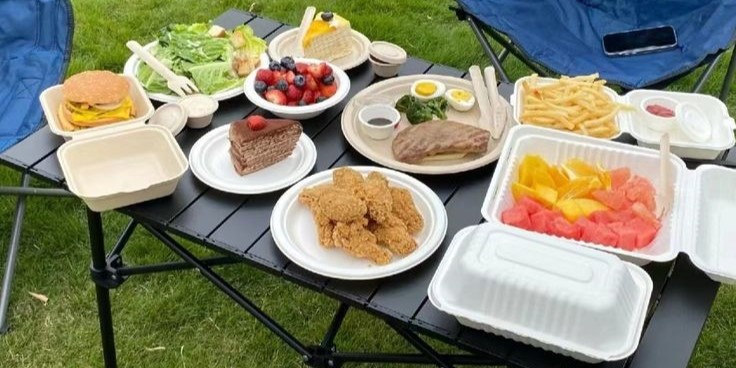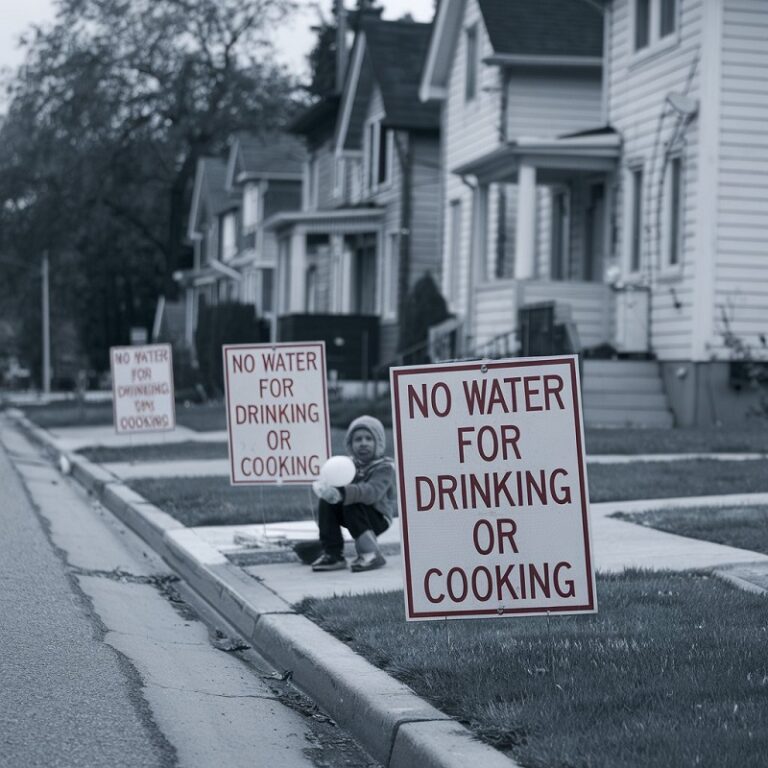From sugarcane fields to your table, bagasse packaging is sure to provide a sustainable solution for your everyday needs. Created from the fibrous byproduct remaining after juice is extracted from sugarcane, this renewable resource is 100% biodegradable and compostable.
Its production helps divert waste from landfills while offering a sustainable alternative to plastic. Lightweight but durable, bagasse packaging works well for takeout boxes, food trays, plates, and cups.
What is Bagasse?
Bagasse is the fibrous residue that remains after juice is extracted from sugarcane in the sugar refining process. In the past, manufacturers considered this as a waste by-product with little to no value. Now, its promise as an upcycled valuable resource is gaining recognition due to its eco-friendly qualities.
Bagasse’s physical structure is primarily made of carbohydrate cellulose, hemicellulose, and lignin. This dense, fibrous quality of this organic residue makes it a natural, plant-based fiber, ideal for sustainable applications. It offers perfect feedstock to produce paper and biodegradable packaging.
This move addresses the demands of eco-minded consumers. The species is highly productive, as sugarcane takes only 12-18 months to fully mature. Worldwide, the sugarcane industry produces approximately 800 million metric tons of bagasse annually.
Its low-carbon footprint and ability to decompose within months appeal to sustainability goals.
Sugarcane to Packaging: The Transformation Process
Sugarcane bagasse goes from field to sustainable packaging in a thoughtful cycle. This trip from farm to table molds agricultural byproducts into eco-friendly alternatives. From cultivation, harvest, and production, each step in this transformation guarantees that the end product is functional, sustainable, and market ready. Here’s a deeper dive into how sugarcane is grown and turned into biodegradable food packaging.
1. Bagasse Collection and Preparation
Once the sugar is pressed out of mature sugarcane stalks, the bagasse—the fibrous residue—is gathered. Cutting sugarcane at peak maturity maximizes fiber content, which is critical for producing quality packaging.
Post-harvest, bagasse is dried, often with rotary or belt dryers, reaching a moisture level under 10%. This step is essential for successfully pulping and molding down the line. Consistent processing creates continuity because the better-quality bagasse will create a stronger and more consistent packaging material, wasting less product in the manufacturing process.
2. Pulping and Screening Processes
Dried bagasse is ground into slurry by a mechanical system, which increases areas of fiber bonding and fiber flexibility. The pulping stage prepares bagasse for molding while maintaining its natural fibers.
Screening then occurs to remove foreign materials, providing a clean and white pulp base. This is where water becomes an unsung hero in bagasse production, dramatically increasing the pulp’s strength and workability. This rebirth process transmutes what was once an agricultural waste product’s potential into a more sustainable and economically attractive raw material for long-lasting packaging alternatives.
3. Molding and Pressing Techniques
It requires high temperatures (between 356°F and 392°F) and even greater pressures (290 – 725 psi). This use of heat and high pressure forces the bagasse pulp into whatever shape is needed.
These procedures provide structural integrity from 725 to 2,175 psi compressive strengths. The ability of bagasse to easily obtain different shapes and sizes makes it apt to be used to produce food containers, plates, and trays. Its low thermal conductivity, 0.03 to 0.04 BTU/(h·ft·°F), further adds to its effectiveness for food insulation.
4. Trimming, Shaping, and Finishing
After cooling, molded items go through trimming to smooth the edges before further shaping molds them into aesthetic and functional designs.
We do extensive quality control standards at this phase. These rigorous tests guarantee that our products meet ASTM D6400 compostability standards, breaking down completely in industrial composting within 90 days.
5. Quality Control and Inspection
Each item is subjected to rigorous testing to ensure strength, resistance to sagging, and safety standards are upheld. Comprehensive testing is conducted to ensure that products are microwave safe, oil resistant, and reliably strong for everyday use.
Second, quality assurance creates confidence, leading to consumer acceptance of this exciting new field and quickly increasing the current $351.60 million bagasse packaging market.
Bagasse Packaging: Properties and Benefits
Bagasseis one of the most sustainable materials for food packaging. Its unique properties provide it an unfair advantage over traditional materials. Its impressive environmental benefits are what make bagasse the clear winner when compared to plastic and Styrofoam. Consumer demand for sustainable solutions has never been higher. Bagasse packaging provides the ideal balance of performance, eco-friendliness, and adaptability.
Durability and Resistance Features
In terms of durability, bagasse packaging is extremely resilient. It is versatile enough to be used for all types of foods, from dry snacks to wet and greasy entrees. Its strong structure is the result of a cellulose content that can reach up to 50%. This provides it a texture like cardboard, which makes sure items are held safe and sound without ripping or draining.
Heat resistance is another important characteristic. With a temperature tolerance of up to 203°F, bagasse is an excellent option for industries that require serving hot or steaming meals, soups, and beverages.
It’s also waterproof, so it’s safe to use even with liquid food! These features contribute to making it a smart, efficient option for a variety of foodservice environments—from the cafeteria to the food truck to the delivery business.
Versatility in Applications
Bagasse can be easily shaped into diverse forms, allowing for products such as food trays, biodegradable disposable cups, and even straws. Its versatility allows for use with steaming hot soups to frozen cold salads.
Its design flexibility is favored by manufacturers, enabling innovation in the development of sustainable products.
Safety and Chemical-Free Composition
Free from harmful toxicities, bagasse food packaging guarantees safe food contact. Its organic nature attracts a consumer base that is increasingly health-conscious, in line with the growing and positive trend away from harmful compounds in packaging.
Thermal Properties and Food Contact
With high thermal insulation, bagasse keeps food hot or cold for longer periods. This ability to pair with diverse cuisines makes it even more valuable in the food industry.
Bagasse vs. Traditional Packaging Materials
As sustainability becomes increasingly important, especially in the foodservice packaging industry, it is important to know how bagasse stacks up with traditional materials such as plastic and paper.
Let’s take a look at the environmental, performance, and cost considerations for these packaging materials.
Environmental Comparison: Bagasse vs. Plastic
The environmental impacts of bagasse and plastic are incomparable. Bagasse, a by-product of sugar production, is both biodegradable and compostable with a natural decomposition occurring in commercial composting facilities within 60–90 days.
In comparison, plastic has been known to last in the wild for hundreds of years.
| Aspect | Bagasse | Plastic |
| Biodegradability | 60–90 days | Centuries |
| Source Material | Renewable (sugarcane) | Fossil fuels |
| Greenhouse Gas Emissions | Low during production | High during production |
Due to bagasse’s abundant, renewable properties, we’ve dramatically decreased the use of non-renewable resources. Its reduced greenhouse gas emissions make it essential in the fight against climate change.
In comparison, choosing bagasse means no long-term environmental footprint.
Performance Comparison: Bagasse vs. Paper
Bagasse stands out when compared to paper packaging.
| Aspect | Bagasse | Paper |
| Durability | High | Moderate |
| Waterproof | Excellent | Prone to soaking |
| Thermal Properties | Microwave-safe, heat-resistant | Limited heat tolerance |
Waterproof combined with heat resistance makes bagasse a great solution for both hot and cold food packaging without leaks.
Compared to their paper counterparts, bagasse containers are microwave-safe, increasing convenience for end-users.
Cost Analysis and Market Trends
The upfront production cost of bagasse is marginally higher than plastic. These costs are countered by eco-friendly incentives and increasing consumer demand for sustainable packaging.
Production prices should come down as production scales, making bagasse increasingly affordable.
From Use to Disposal: End-of-Life Options
For businesses looking for a sustainable alternative to plastic, bagasse packaging is a great solution. Its sustainability is contingent on proper treatment post-consumption. Due to its natural biodegradability, bagasse can be disposed of in multiple ways, each with unique environmental advantages.
These options include composting, recycling, and energy recovery, and they are heavily influenced by existing regional infrastructure and consumer habits. Knowing these pathways is necessary to make the most of its environmental promise.
Composting Bagasse Packaging at Home
Home composting is the most convenient and consumer-friendly method for managing bagasse packaging. To start, you’ll need to remove any non-compostable elements like food scraps or labels.
Next, shred the bagasse into smaller pieces for quicker breakdown. Place it in your compost bin, along with a healthy ratio of greens (food waste) and browns (leaves, cardboard).
Lastly, maintain proper aeration and moisture for efficient decomposition. Like any organic material, bagasse needs warm, moist conditions in order to break down efficiently.
In as few as 90 days, it will break down into nutrient-rich compost. This closed-loop process prevents waste from ending up in landfills. It improves the soil of home gardens, promotes more vigorous plants, and lessens dependence on chemical fertilizers.
Industrial Composting Processes
For areas with industrial composting infrastructure, bagasse packaging can be handled on a more industrialized, large-scale process. In these industrial facilities, controlled environments using higher temperatures and optimized conditions decompose materials more quickly and efficiently.
This is particularly striking when it comes to managing tons of waste. Infrastructure for industrial composting minimizes greenhouse gas emissions and diverts tons of waste from landfills. This not only cuts down your business’s footprint but also contributes to global sustainability efforts.
Recycling Potential and Challenges
Unlike composting, recycling bagasse packaging is not as prevalent but is still possible. The biggest hurdles are food residue contamination and a lack of recycling infrastructure.
Expanding facilities and developing innovative recycling methods could unlock new possibilities for reusing bagasse materials. This would significantly reduce reliance on virgin resources.
Responsible Disposal Methods
- Compost at home or through industrial facilities.
- Recycle where infrastructure is available.
- As a last resort, dispose of in regular waste bins if no other disposal option is available.
Educating consumers and improving our waste management systems are essential steps toward making any end-of-life disposal activity responsible and sustainable. Partnerships between lawmakers, companies, and consumers can help strengthen these efforts and make waste reduction the standard.
The Growing Adoption of Bagasse Packaging
As governments impose stricter regulations on single-use plastics, the demand for compostable and plant-based alternatives is soaring. Many industries have already embraced bagasse packaging, including:
- Restaurants & Cafés: Fast food chains, coffee shops, and catering services are replacing plastic and Styrofoam with bagasse plates, bowls, and clamshell containers.
- Retail & Supermarkets: Grocery stores are introducing compostable food trays and produce packaging made from bagasse.
- Events & Festivals: Large gatherings and eco-conscious events are switching to bagasse tableware to reduce plastic waste.
- Corporate Sustainability Programs: Businesses looking to enhance their sustainability credentials are adopting bagasse packaging as part of their green initiatives.
At the same time, rising consumer awareness is pushing brands to adopt eco-friendly packaging solutions. More shoppers now look for compostable and biodegradable labels when purchasing products, encouraging a shift toward greener choices.
Conclusion
The journey of bagasse—from sugarcane field to biodegradable packaging—illustrates how waste can be transformed into a practical, sustainable solution for everyday use. As the world moves away from plastic dependence, bagasse packaging stands out as a renewable, compostable, and functional alternative.
By choosing bagasse-based products, consumers and businesses can actively reduce waste, support a circular economy, and make a meaningful impact on the planet. Companies like InNature Pack are making it easier to switch to sustainable packaging by offering high-quality bagasse-based alternatives for various industries. The next time you enjoy a takeout meal in a bagasse container, remember—you’re holding a piece of sugarcane’s sustainable second life.
Frequently Asked Questions
What is bagasse?
Bagasse is the fibrous byproduct remaining after extracting juice from sugarcane. Because it is biodegradable and sustainable, it is frequently used to create eco-friendly packaging.
How is bagasse transformed into packaging?
Once the sugar has been extracted, the collected bagasse is further cleaned before being pulped and molded into sustainable bagasse products, reducing waste and revitalizing agricultural byproducts.
Why is bagasse packaging considered eco-friendly?
They’re biodegradable, compostable, and made from renewable materials. In contrast to plastic, it helps reduce landfill waste and degrades naturally in just months.
What are the key benefits of bagasse packaging?
Bagasse is heat-resistant, microwave-safe, sturdy, and can be water-resistant. It’s a supercharged alternative to plastic and foam packaging. It’s perfect for food service!
How does bagasse compare to traditional packaging materials?
Bagasse products are a clear winner compared to traditional plastic and Styrofoam alternatives, as they are biodegradable and sustainable, breaking down more quickly when exposed to natural elements.
Is bagasse packaging safe for food use?
Yes, all bagasse packaging is FDA-approved for direct food contact. It’s non-toxic, heat safe and does not leach harmful chemicals into food.





